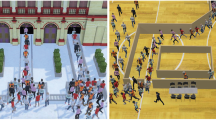Abstract
Ever since the first use of crowds in films and video games there has been an interest in larger, more efficient and more realistic simulations of crowds. Most crowd simulation algorithms are able to satisfy the viewer from a distance but when inspected from close up the flaws in the individual agent’s movements become noticeable. One of the bigger challenges faced in crowd simulation is finding a solution that models the actual movement of an individual in a crowd. This paper simulates a more realistic crowd by using individual motion capture data as well as traditional crowd control techniques. By augmenting traditional crowd control algorithms with the use of motion capture data for individual agents, we can simulate crowds that mimic more realistic crowd motion, while maintaining real-time simulation speed.
Access this chapter
Tax calculation will be finalised at checkout
Purchases are for personal use only
Similar content being viewed by others
References
Reynolds, C.: Flocks, herds and schools: a distributed behavioral model. In: ACM SIGGRAPH Computer Graphics, vol. 21, pp. 25–34. ACM (1987)
Massive Software (2015). http://massivesoftware.com
Golaem Software (2015). http://golaem.com
Amkraut, S., Girard, M., Karl, G.: Eurythmy. SIGGRAPH Video Rev. 21, 329–336 (1985)
Reynolds, C.: Steering behaviors for autonomous characters. In: Game Developers Conference (1999). http://wwwred3d.com/cwr/steer/gdc99
Fiorini, P., Shiller, Z.: Motion planning in dynamic environments using the relative velocity paradigm. In: Proceedings of 1993 IEEE International Conference on Robotics and Automation, pp. 560–565. IEEE (1993)
Van den Berg, J., Lin, M., Minocha, D.: Reciprocal velocity obstacles for real-time multi-agent navigation. In: ICRA 2008, IEEE International Conference on Robotics and Automation, pp. 1928–1935. IEEE (2008)
Xiong, M., Lees, M., Cai, W., Zhou, S., Low, M.Y.H.: A rule-based motion planning for crowd simulation. In: CW 2009, International Conference on CyberWorlds 2009, pp. 88–95. IEEE (2009)
Helbing, D., Molnar, P.: Social force model for pedestrian dynamics. Phys. Rev. E 51(5), 4282 (1995)
Braun, A., Musse, S.R., De Oliveira, L.P., Bodman, B.E.: Modeling individual behaviors in crowd simulation. In: 16th International Conference on Computer Animation and Social Agents, 2003, pp. 143–148. IEEE (2003)
Pelechano, N., Allbeck, J., Badler, N.: Controlling individual agents in high-density crowd simulation. In: Proceedings of the 2007 ACM SIGGRAPH/Eurographics Symposium on Computer Animation, pp. 99–108. Eurographics Association (2007)
Ricks, B.C., Egbert, P.K.: More realistic, flexible, and expressive social crowds using transactional analysis. Vis. Comput. 28(6–8), 889–898 (2012)
Kim, S., Guy, S.J., Manocha, D., Lin, M.C.: Interactive simulation of dynamic crowd behaviors using general adaptation syndrome theory. In: Proceedings of the ACM SIGGRAPH Symposium on Interactive 3D Graphics and Games, pp. 55–62. ACM (2012)
Blue, V.J., Adler, J.L.: Cellular automata microsimulation for modeling bi-directional pedestrian walkways. Transp. Res. Part B: Methodological 35(3), 293–312 (2001)
Schadschneider, A.: Cellular automaton approach to pedestrian dynamics-theory. arXiv preprint cond-mat/0112117 (2001)
Burstedde, C., Klauck, K., Schadschneider, A., Zittartz, J.: Simulation of pedestrian dynamics using a two-dimensional cellular automaton. Phys. A 295(3), 507–525 (2001)
Hamagami, T., Hirata, H.: Method of crowd simulation by using multiagent on cellular automata. In: IAT 2003, IEEE/WIC International Conference on Intelligent Agent Technology, pp. 46–52. IEEE (2003)
Chenney, S.: Flow tiles. In: Proceedings of the 2004 ACM SIGGRAPH/Eurographics symposium on Computer animation, Eurographics Association, pp. 233–242 (2004)
Tecchia, F., Loscos, C., Conroy-Dalton, R., Chrysanthou, Y.L.: Agent behaviour simulator (abs): A platform for urban behaviour development (2001)
Musse, S.R., Jung, C.R., Jacques, J., Braun, A.: Using computer vision to simulate the motion of virtual agents. Comput. Animation Virtual Worlds 18(2), 83–93 (2007)
Zhong, J., Cai, W., Luo, L., Yin, H.: Learning behavior patterns from video: a data-driven framework for agent-based crowd modeling. In: Proceedings of the AAMAS (2015)
Ahn, J., et al.: Long term real trajectory reuse through region goal satisfaction. In: Allbeck, J.M., Faloutsos, P. (eds.) MIG 2011. LNCS, vol. 7060, pp. 412–423. Springer, Heidelberg (2011)
Lee, K., Choi, M., Hong, Q., Lee, J.: Group behavior from video: a data-driven approach to crowd simulation. In: Proceedings of the 2007 ACM SIGGRAPH/Eurographics Symposium on Computer Animation, pp. 109–118. Eurographics Association (2007)
Courty, N., Corpetti, T.: Crowd motion capture. Comput. Animation Virtual Worlds 18(4–5), 361–370 (2007)
Pelechano, N., Spanlang, B., Beacco, A.: Avatar locomotion in crowd simulation. In: International Conference on Computer Animation and Social Agents (CASA) (2011)
Kim, J., Seol, Y., Kwon, T., Lee, J.: Interactive manipulation of large-scale crowd animation, ACM Trans. Graph. 33(4), Article 83 (2014)
Lee, K.H., Choi, M.G., Lee, J.: Motion patches: building blocks for virtual environments annotated with motion data, In: ACM SIGGRAPH 2006 Papers (SIGGRAPH 2006), pp. 898–906. ACM, New York (2006)
Lemercier, S., Moreau, M., Moussaïd, M., Theraulaz, G., Donikian, S., Pettré, J.: Reconstructing motion capture data for human crowd study. In: Allbeck, J.M., Faloutsos, P. (eds.) MIG 2011. LNCS, vol. 7060, pp. 365–376. Springer, Heidelberg (2011)
Lerner, A., Chrysanthou, Y., Lischinski, D.: Crowds by example. In: Computer Graphics Forum, vol. 26, pp. 655–664. Wiley Online Library (2007)
Carnegie Mellon University. CMU graphics lab motion capture database. http://www.mocap.cs.cmu.edu
Egbert, C., Egbert, P.K., Morse, B.S.: Real-time motion transition by example. In: Perales, F.J., Fisher, R.B. (eds.) AMDO 2010. LNCS, vol. 6169, pp. 138–147. Springer, Heidelberg (2010)
Kovar, L., Gleicher, M., Pighin, F.: Motion graphs. In: ACM SIGGRAPH 2008 Classes, p. 51. ACM (2008)
Ondrej, J., Pettre, J., Olivier, A.H., Donikian, S.: A synthetic-vision based steering approach for crowd simulation. ACM Trans. Graph. (TOG) 29(4), 123 (2010)
Author information
Authors and Affiliations
Corresponding author
Editor information
Editors and Affiliations
Rights and permissions
Copyright information
© 2016 Springer International Publishing Switzerland
About this paper
Cite this paper
Brunner, S., Ricks, B., Egbert, P.K. (2016). Realistic Crowds via Motion Capture and Cell Marking. In: Perales, F., Kittler, J. (eds) Articulated Motion and Deformable Objects. AMDO 2016. Lecture Notes in Computer Science(), vol 9756. Springer, Cham. https://doi.org/10.1007/978-3-319-41778-3_7
Download citation
DOI: https://doi.org/10.1007/978-3-319-41778-3_7
Published:
Publisher Name: Springer, Cham
Print ISBN: 978-3-319-41777-6
Online ISBN: 978-3-319-41778-3
eBook Packages: Computer ScienceComputer Science (R0)




